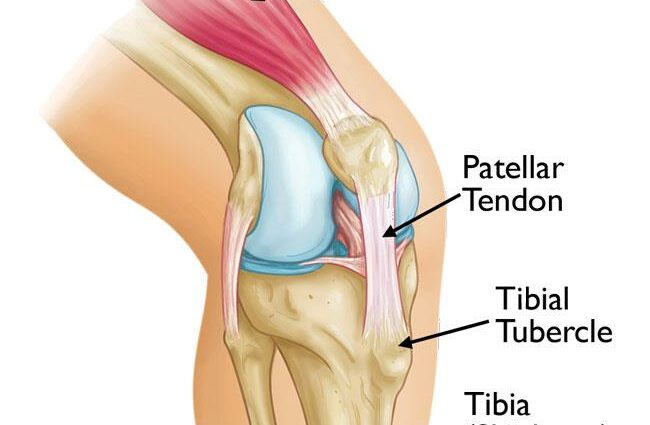Contents
Inflammation of the growing cartilage of the knee
Osgood-Schlätter disease is a painful inflammation of bone and cartilage, localized in the upper part of the tibia, below the knee joint.
In medical jargon, we speak osteochondrosis or anterior tibial osteochondritis, since it occurs at the level of the low insertion of the tendon of the patella, at the level of the anterior tibial tuberosity (or TTA), namely the bony prominence in front of the tibia.
This pathology was first discovered and described in 1903 by Drs Osgood and Schlätter, who gave it their joint names. Osgood-Schlätter disease is usually unilateral, and mainly concerns sporty children and young adolescents aged 10 to 15. Although the gender gap is narrowing, boys still tend to be more affected than girls, due to greater participation in sport. This pathology affects 4% of all adolescents, and about 20% of athletic adolescents.
This local inflammation of the growing cartilage results fromintense sports practice with excessive strain on the affected leg. In detail, it is the overworking of the cartilage due to the repetition of gestures in extension (as for shooting a ball) that leads to micro-trauma. This phenomenon is all the more present in the event of rapid growth, of intense sporting activity (football in particular, and other high impact sports), and possibly of too much joint stiffness.
Osgood-Schlätter disease: what symptoms and who to consult?
The main symptom of Osgood-Schlätter disease is pain : the child complains of having pain every time he moves the affected area, for example during sports or when he goes up or down a staircase. The pain worsens during activity, and decreases at rest.
Another more impressive symptom can occur: it is the swelling of the front of the knee, due to local inflammation. The area is swollen, tender, painful to the touch. Micro-trauma may indeed have resulted in a bone growth, which is small fractures (micro-tearing of a piece of bone), due to a still incomplete ossification.
Although it seems complex, this disease can be diagnosed by a general practitioner, and rarely requires the intervention of a specialist (rheumatologist). On the other hand, it may be wise to consult a physiotherapist after resting, for a smooth practice and resumption of sport.
A radio to ensure the diagnosis
While the clinical examination may be sufficient to diagnose Osgood-Schlätter disease in the face of very suggestive symptoms, the doctor may still order an X-ray, in particular If in doubt.
The X-ray radiography will make sure that it is indeed this type of osteochondrosis, and in will determine the stage, the severity. An X-ray could thus highlight a significant fragmentation of the tibial tuberosity, this bony prominence located in front of the tibia.
The radio is particularly indicated if the child or adolescent has other symptoms, such as severe swelling, redness, or warming of the area. Because these can be the sign of an inflammation of the joint or of a more important fracture, in particular in the event of acute pain. The treatment will then be different.
Treatment: how to treat Osgood-Schlätter disease?
Treatment is rarely surgical. In the majority of cases, and in the absence of complications, doctors prescribe stopping sport, rest, and taking analgesics and non-steroidal anti-inflammatory drugs (NSAIDs, such as ibuprofen) for pain. A simple treatment of at least one to six months if not longer, which is not always well accepted by sports-loving adolescents.
Muscle stretching by physiotherapy may be indicated for a gradual resumption of sport, especially in the event of muscle stiffness. The wearing of a knee brace or an orthosis can also be prescribed, to reduce pain in the event of physical exertion or even at rest, although the usefulness of these medical devices is disputed in this pathology.
In the event of severe pain and / or difficulty in staying at rest, a cast can be placed, but this is a fairly rare treatment because it is restrictive for the child.
Note that the onset of Osgood-Schlätter disease can be the opportunity for parents and children to rethink their sport a little, why not by reducing the intensity a little, by listening to yourself more or by diversifying the sports practiced. It may also be wise to reveal a possible vitamin D deficiency with a blood test.
Surgery is very rarely considered, and reserved for the most severe cases, and in the absence of improvement despite being put to rest. It should generally be performed in adulthood, when the growth is fully completed.
Keep in mind that this is a mild disease with a good long-term prognosis, and the majority of affected children recover easily.










